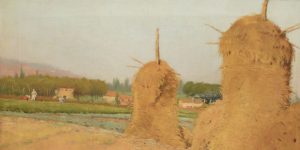2 results
Biografia
Joaquim Mir is undoubtedly the great Spanish landscape painter of the late 19th and early 20th centuries. His personal pictorial approach, daring and intuitive, is the result of constant, courageous and limitless experimentation, which led him to achieve unique results.
Although enrolled at the Barcelona School of Fine Arts, Mir developed a self-taught education, combined with classes at the private academy of the painter Lluís Graner (1863–1929). Interested in the theme of landscape, at the beginning of his relationship with a group of artists of his generation with whom he captured suburban landscapes in which yellows are protagonists; among them, creators such as Isidre Nonell (1872–1911), Ricard Canals (1876–1931) or Ramon Pichot (1872–1925) stand out. Mir was part of the circle of Barcelona modernists who met in the Els Quatre Gats tavern, where he met young Picasso (1881–1973). There he regularly exhibited since 1897, combining these exhibitions with others of a more formal nature, such as those held in the Sala Parés.
Despite some specific recognition, such as medals in official competitions and some honorable mention, Mir decided to move away from the artistic circuit to find a personal language with which to express himself freely. This motivation led him to settle in Mallorca in 1899, where he was fascinated by pure and wild nature, hardly intervened by man. The caves, streams and coves became the protagonists of his compositions. This was surely one of the main moments in his career, since there he shaped a new way of painting, in which arbitrary colors and brushstrokes create intuitive and free compositions that flirt with abstraction.
In 1904, the artist suffered a fall that left him unconscious and forced him to return to Catalonia to be admitted to the Pere Mata Psychiatric Institute in Reus for almost two years.
Later he settled in the Camp de Tarragona, where he continued with his free interpretation of the landscape, a synthesis that sometimes approaches abstraction. Despite the audacity of his approach to art, his painting began to be valued for its bold and different result. Thus, the exhibitions in the Sala Parés followed one another continuously, especially when Mir was already in full maturity and his vibrant landscaping began to be more moderate and contained. In 1921 he established his permanent residence in Vilanova i la Geltrú, where he lived until his death in 1940. This stage represented his consolidation in the art market, not only local but also international, since he participated in exhibitions held in London and Buenos Aires, where his works were valued and acquired for integrating important collections of the time.
His independence led him to make an authentic and profound revolution in his painting, where the stain, the impression, the arbitrary color, the spontaneity and the freedom of the brushstroke configure works that exceed the initial approach of Fauvism, and that even advanced to abstraction and avant-garde of the early 20th century.



